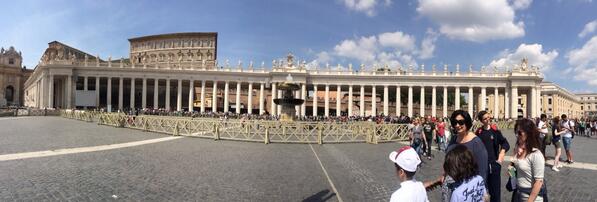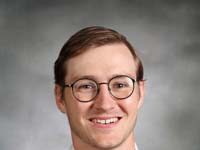Having seen Pope John Paul II from an audience on three different occasions at World Youth Day in 2002, in Rome in 2003, and on a family trip in 2000, Jesuit Geometry and Pre-Calculus teacher Mr. Paul Kolker found extra meaning in the fact that a saint who he had personally seen and learned from was to be canonized during his lifetime.
 He decided to travel with friends and family to Rome for the April 27 canonization. He explained that it was incredible for him “to be able to be there at the canonization of a man who I had personally seen with my eyes not just on TV but just in person. Usually you think of a saint as someone from the fifteen hundreds. You almost think of them as a legend or a myth or a story. But he is not. This is a man who I saw not only as a person but also a lot of the effects of what he did. I felt the effects because some of what he thought directly changed the way I approached life. To be there and to hear him be named a saint by the church is surreal. A very grace-filled experience.” Also elevated to sainthood at the ceremony was Pope John XXIII, who convened the Second Vatican Council and was known for his warm, pastoral style.
He decided to travel with friends and family to Rome for the April 27 canonization. He explained that it was incredible for him “to be able to be there at the canonization of a man who I had personally seen with my eyes not just on TV but just in person. Usually you think of a saint as someone from the fifteen hundreds. You almost think of them as a legend or a myth or a story. But he is not. This is a man who I saw not only as a person but also a lot of the effects of what he did. I felt the effects because some of what he thought directly changed the way I approached life. To be there and to hear him be named a saint by the church is surreal. A very grace-filled experience.” Also elevated to sainthood at the ceremony was Pope John XXIII, who convened the Second Vatican Council and was known for his warm, pastoral style.
Pope John Paul II was considered by many to be a saint from the moment he died, when Roman crowds chanted repeatedly “Santo Subito!” (“[Make him a] Saint Immediately!” at his funeral Mass in 2005.
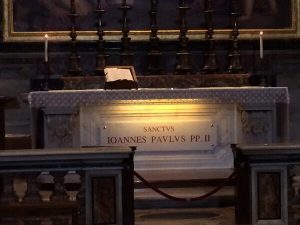 This outpouring likely inspired Pope Benedict XVI to bypass the five-year wait normally required for beautification and canonization. Usually, two or more miracles must be attributed to the candidate’s intercession before canonization. For Pope John Paul II, the two miracles were the cure of a Costa Rican mother from an inoperable brain aneurism and the cure of a French nun from Parkinson’s, a disease that JPII had suffered from as well. Both women prayed for his intercession, and were miraculously cured beyond scienctific medical explanation.
This outpouring likely inspired Pope Benedict XVI to bypass the five-year wait normally required for beautification and canonization. Usually, two or more miracles must be attributed to the candidate’s intercession before canonization. For Pope John Paul II, the two miracles were the cure of a Costa Rican mother from an inoperable brain aneurism and the cure of a French nun from Parkinson’s, a disease that JPII had suffered from as well. Both women prayed for his intercession, and were miraculously cured beyond scienctific medical explanation.
Pope John Paul II’s teachings on the Theology of the Body, his weekly Wednesday Audiences and his establishment of the annual World Youth Day are a few of his remarkable papal achievements. His teachings emphasized what it means to be human and how to live fully human.
J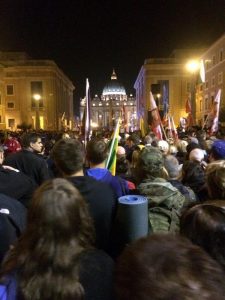 ohn Paul II was born Karol Wojtyla in Poland. He lived through the Nazi occupation and secretly attended the seminary to become a priest. He was highly intelligent, a master of several languages, personable, outgoing, but especially deeply spiritual. Witnesses described him groaning out loud during his daily morning prayer of up to an hour in length.
ohn Paul II was born Karol Wojtyla in Poland. He lived through the Nazi occupation and secretly attended the seminary to become a priest. He was highly intelligent, a master of several languages, personable, outgoing, but especially deeply spiritual. Witnesses described him groaning out loud during his daily morning prayer of up to an hour in length.
Kolker emphasized the reason for his admiration for John Paul II: “He was just really helping people to see that the faith is alive. It isn’t something [that is] dead, that God is real and that he’s active.”
Kolker, along with some family and friends, traveled first to Assisi and went to St. Clare’s Church, as well as the Basilica of Saint Francis and the hermitage where St. Francis lived and later St. Bernard of Clairvaux. They also saw the refectory where St. Francis ate with other Franciscans.
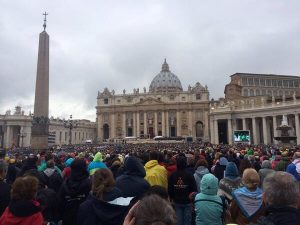 Kolker described it as “a beautiful time of being both in a beautiful medieval city in Italy and kind of seeing the past of Italy and living and walking with the saints as we prepared for this moment for receiving a new saint in the Church.” The visit also held special significance because Pope Francis chose his papal name to honor the saint of Assisi
Kolker described it as “a beautiful time of being both in a beautiful medieval city in Italy and kind of seeing the past of Italy and living and walking with the saints as we prepared for this moment for receiving a new saint in the Church.” The visit also held special significance because Pope Francis chose his papal name to honor the saint of Assisi
Kolker explained, “It was really cool to get in touch with Pope Francis through these other saints.”
The group then went to Rome and toured almost “nonstop,” starting with the Basilica of St. John Lateran, home church of the pope as Bishop of Rome. At multiple churches, Kolker’s group was fortunate for “right when they showed up Mass was starting, like God had planned [their] prayer.”
Kolker himself gave his family and friends a tour of St. Peter’s Basilica, drawing on his time lived in Rome. Under the massive church, a crypt contains the tombs of the popes. The canonized or beatified popes rest above in the actual basilica. Both John Paul II and John XXIII were there. Miraculously, Saint John XXIII’s body has not decayed after 51 years!
 Kolker and his group waited in line with 500,000 others that Saturday night, camping out on the streets of Rome to get a spot at the canonization Mass. At first, everyone was relaxed, singing in different languages. Then, people got antsy, trying to move their way forward for better position. At 1 a.m. the crowd burst through original barricades. The piazza opened at 5 a.m.. Standing for 5-6 straight hours, Kolker exclaimed that “you could literally fall asleep and not fall over because you had bodies pressing against you. They finally arrived at St. Peter’s at 7:30 a.m. for the 10 a.m. Mass.
Kolker and his group waited in line with 500,000 others that Saturday night, camping out on the streets of Rome to get a spot at the canonization Mass. At first, everyone was relaxed, singing in different languages. Then, people got antsy, trying to move their way forward for better position. At 1 a.m. the crowd burst through original barricades. The piazza opened at 5 a.m.. Standing for 5-6 straight hours, Kolker exclaimed that “you could literally fall asleep and not fall over because you had bodies pressing against you. They finally arrived at St. Peter’s at 7:30 a.m. for the 10 a.m. Mass.
During the wait, Kolker slept on the cobblestone street. Finally, the Mass began. Pope Francis presided, joined by Pope Emeritus Benedict XVI, 500 bishops, 150 cardinals, and 1,000 priests.
 Kolker noted that “it renewed my desire to say yes to whatever God wants for my life. Seeing what had happened in the lives of these two men who said yes made me say, ‘Why am I any different?'”
Kolker noted that “it renewed my desire to say yes to whatever God wants for my life. Seeing what had happened in the lives of these two men who said yes made me say, ‘Why am I any different?'”
The whole event was very “hectic,” as is anything organized in Italy, said Kolker. “Whenever we returned to the United States, some of the guys said, ‘I’m so glad to be back in the United States of Organization.'”
After standing in line 7 hours, Kolker needed to use the restrooms located at back of line. He had to pass through and over the crowd, persuade a medical staffer and get by the military police, both ways to regain his spot.
When asked his favorite part of the trip, Kolker asserted that it “was definitely not standing in line.” The canonization Mass was “definitely” the highlight of the trip.
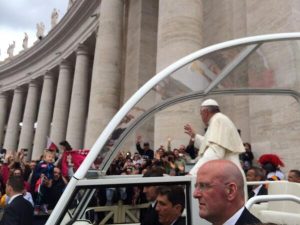 Poignantly, a close family relative passed away during the trip. Though it was a sad time, his group knew that they could ask for the intercessions of all the saints at the places that they went to. Kolker added that “it was hard not to be able to be there with the family, but then there was something powerful about feeling like we could pray for her almost better than if we had went there. When you take the intentions of other people with you on a pilgrimage, that’s a special kind of prayer that God acknowledges, I believe, and the Church teaches that.”
Poignantly, a close family relative passed away during the trip. Though it was a sad time, his group knew that they could ask for the intercessions of all the saints at the places that they went to. Kolker added that “it was hard not to be able to be there with the family, but then there was something powerful about feeling like we could pray for her almost better than if we had went there. When you take the intentions of other people with you on a pilgrimage, that’s a special kind of prayer that God acknowledges, I believe, and the Church teaches that.”
Mr. Kolker described the Mass as an ineffable moment that he will always cherish:
“The actual canonization mass is hard to put into words. It’s still something where I look back at it and am like did that really happen, was I really there. Because i have never been to a canonization. The canonizations that they have had have been for lesser known saints. Other parts of the world might have known about them, but I had never known about them before. I don’t really know them or have that connection. But to be there for someone that I had read what he wrote and heard what he taught and seen him in person. There’s not a lot of words. It just hits you. I’m just grateful. I don’t know how else to put it.”


